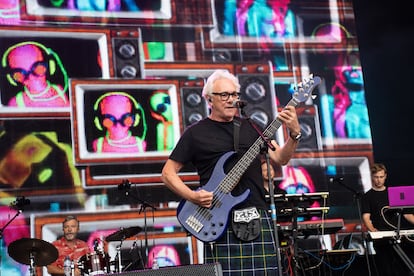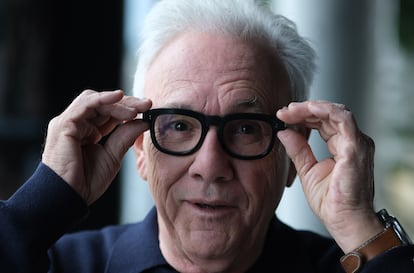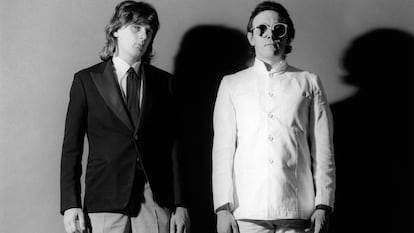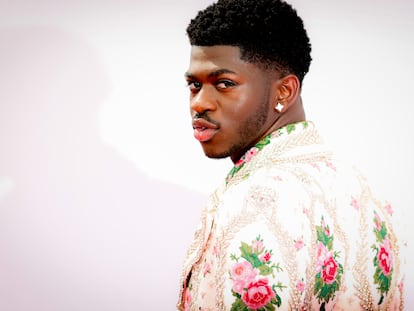Trevor Horn, the man who composed ‘Video Killed The Radio Star’: ‘I can’t tell the difference between pop singers, because everybody uses autotune’
Still active with a half-a-century-long career under his belt, the British producer of Paul McCartney and John Legend designed the sound of 1980s pop music

Beat Box is one of the most popular songs by the mysterious English band Art of Noise. Released 40 years ago, in December 1983, it’s a four-minute-long instrumental piece that uses noises — such as an engine starting, or water going down a drain — to accompany a powerful drum rhythm. Despite its sound — certainly experimental for the time period — it reached the top of the Billboard charts in 1984, becoming the most-listened-to song in America’s nightclubs for several weeks. Many hip hop groups have recognized the influence of this song in the development of the genre.
Without promotional photos — and performing with masks to hide the identities of its members — the career of the futuristic and influential Art of Noise is truly fascinating, especially thanks to the revolutionary use of the sampler: an electronic musical instrument that records and plays back clips of ordinary sounds.
Trevor Horn, 74, was one of the members of the group, along with Gary Langan, J. J. Jeczalik, Anne Dudley and Paul Morley. An iconic name in pop-rock, he saw — before anyone else — the possibilities of a digital synthesizer called Fairlight CMI — an Australian invention for recording and releasing sounds. “I never learned to use it completely, because the manual was too thick. I would have had to stop production — or even eating — to read it. We invented something new that has marked today’s music,” Horn recalls.

Dressed all in black, wearing sneakers and thick-rimmed glasses, Horn has gray hair and an elegant demeanor. He’s smiling, even though he’s been awake since 4 a.m. to catch one of the first flights from London to Madrid.
Today, he hasn’t been able to carry out his daily routine: waking up at 8 a.m., taking his grandchildren to school and going into the recording studio he has in the basement of his house — a mansion in West London that once belonged to the actor Bob Hoskins. He no longer has a trace of the northern English accent that he became known for in his music. Today, Horn — who started out as a freelance bassist and a Bob Dylan imitator — is mostly known for Art of Noise, but he actually made it big the year before Beat Box was released, when he produced the hit debut single Relax — the legendary song by the British pop band, Frankie Goes to Hollywood. It was one of the best-selling singles in the history of the United Kingdom. When Horn worked on it in 1983, he already knew it would be a success.
“When I started, it cost so much money to get into a recording studio that people would only pay you if you were able to create something that sold records. Now, it’s very easy to make a record in your bedroom. You can buy the equipment for a few thousand dollars. And yet, a lot of the young people are doing what you would probably just call commercial songs. It’s terrible, I can’t tell the difference between current pop singers, because everyone uses autotune,” he laments.
Horn was also one of the composers of Video Killed the Radio Star (1979), by the Buggles. He also joined Yes — a progressive rock band — and produced icons such as Seal, Grace Jones, Paul McCartney, Belle & Sebastian, t.A.T.u. and John Legend. “By the way, on the new album, I did use autotune on some specific notes,” he admits. “But you won’t be able to notice.” He mentions some of the stars — such as Tori Amos, Rick Astley, Robert Fripp and Iggy Pop — who have collaborated on Echoes: Ancient & Modern (2023), an album of cover songs. It’s been released on a prestigious label that’s known for classical music: Deutsche Grammophon. “It’s a German label. Most of the recording technology was invented in Germany, like analog tape. In my studio, I still use my Telefunken microphones from 1953,” he says.
Technology had a lot to do with Trevor Horn’s ability to innovate, as it satisfied an insatiable natural curiosity. “I went from doing pop with ABC to working with the father of punk, Malcolm McLaren… I didn’t want to get bored,” he jokes. However, he also credits his creativity to the “tons” of weed he smoked — consumption that he wrote about in his autobiography, Adventures in Modern Recording (2022).
Technology and weed certainly explain the 10-minute-long Moments in Love, perhaps the most perfect pop song ever written. “Yes, it’s a pop single, but with the wrong elements in it,” he reflects, laughing. “I think marijuana changed things in the 1960s, because, you know, one minute the Beatles were wearing nice suits and hairdos, and the next, their album Sgt. Pepper’s Lonely Hearts Club Band comes out and everyone is stoned out of their brains. Drugs contributed to the expansion of music in each era, but I think technology is more important.”
“Technology and music have always been part of the same thing, even in the early days, when cathedrals were built, because the cathedral was the original reverb unit, where any music would sound fantastic. That was the vision of heaven for the Church; when you went there on Sunday with the heavenly choir singing. And, before rock and pop, the modern symphony orchestra was a great feat of engineering. All instruments beautifully made and in tune,” he reflects, adding that artificial intelligence won’t change the music at all, “because AI is just tricks.” Still, the verses written by Horn in 1979 for Video Killed the Radio Star resonate today more than ever: “They took the credit for your second symphony / Rewritten by machine on new technology.”

The British producer mentions The Beatles not by chance: the most perfectionist producers in history (he spent days and days doing multiple takes with John Legend to achieve the desired effect) says they are one of his favorite groups. “I’m not one of those artists who mention an unknown band to seem superior to others. I grew up with The Beatles: I was 13-years-old when they were big and watching them was what made me want to be in a band and play bass.”
“What surprises me about The Beatles,” he continues, “is that when I listen to them, I realize that all three of them had almost the same voice. They had different versions of the same voice. They could have been brothers because of the way their voices resembled each other. Paul McCartney didn’t have the high, flexible voice that John Lennon had. He had a slightly deeper voice… but very gritty. And George Harrison had a lovely voice, thick and deep. Even today, I’m surprised when I listen to them: 40 or 50 years have passed and the sound of their voices together is still quite the amazing thing to me,” he sighs, visibly moved.
Many singers speak precisely of Horn’s talent for recording them and getting the best out of them. “It wasn’t a magic trick — it was hard work. But you know, it’s true that people always sing better when they feel happy. Or if they’re feeling sad, but they’re happy about being sad. You’ve just got to make them feel comfortable. And make them feel that you’re listening, that you’re paying attention. In a way, when someone sings in a recording studio, you’re a one-man audience. And you have to react like an audience to get the person excited,” he affirms.
His life has had everything, along with tragedy. His wife — Jill Sinclair, co-manager of ZTT Records with Horn — passed away in 2014, after being in a coma for several years, after one of their four children accidentally fired a rifle in the wrong direction. “When she was gone, I realized how much of the bad part of the music business she kept away from me. With her death, I lost that protection. Before her accident, I could just concentrate on music,” he says, before immediately changing the subject. In 2023, he notes, he did 80 live concerts, remembering that music (and perhaps technology and drugs) will always be there to save people.
Sign up for our weekly newsletter to get more English-language news coverage from EL PAÍS USA Edition
Tu suscripción se está usando en otro dispositivo
¿Quieres añadir otro usuario a tu suscripción?
Si continúas leyendo en este dispositivo, no se podrá leer en el otro.
FlechaTu suscripción se está usando en otro dispositivo y solo puedes acceder a EL PAÍS desde un dispositivo a la vez.
Si quieres compartir tu cuenta, cambia tu suscripción a la modalidad Premium, así podrás añadir otro usuario. Cada uno accederá con su propia cuenta de email, lo que os permitirá personalizar vuestra experiencia en EL PAÍS.
¿Tienes una suscripción de empresa? Accede aquí para contratar más cuentas.
En el caso de no saber quién está usando tu cuenta, te recomendamos cambiar tu contraseña aquí.
Si decides continuar compartiendo tu cuenta, este mensaje se mostrará en tu dispositivo y en el de la otra persona que está usando tu cuenta de forma indefinida, afectando a tu experiencia de lectura. Puedes consultar aquí los términos y condiciones de la suscripción digital.
More information
Archived In
Últimas noticias
Iranian women are also defying the taboo of riding motorcycles (and without a license)
David Bowie, the galactic thinker who encouraged us to break new ground
John Berger and the loss of rural culture
From police officer to bloodthirsty kidnapper: Terror in Mexico during the years of ‘The Ear Chopper’
Most viewed
- David King, chemist: ‘There are scientists studying how to cool the planet; nobody should stop these experiments from happening’
- Reinhard Genzel, Nobel laureate in physics: ‘One-minute videos will never give you the truth’
- Oona Chaplin: ‘I told James Cameron that I was living in a treehouse and starting a permaculture project with a friend’
- Mexico completes its trade shift with the entry into force of tariffs on China and countries without trade agreements
- Sinaloa Cartel war is taking its toll on Los Chapitos










































